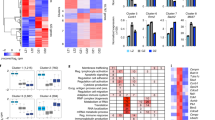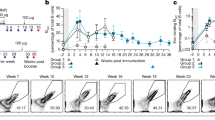Abstract
After antigenic challenge, B cells enter the dark zone (DZ) of germinal centers (GCs) to proliferate and hypermutate their immunoglobulin genes. Mutants with greater affinity for the antigen are positively selected in the light zone (LZ) to either differentiate into plasma and memory cells or reenter the DZ. The molecular circuits that govern positive selection in the GC are not known. We show here that the GC reaction required biphasic regulation of expression of the cell-cycle regulator c-Myc that involved its transient induction during early GC commitment, its repression by Bcl-6 in DZ B cells and its reinduction in B cells selected for reentry into the DZ. Inhibition of c-Myc in vivo led to GC collapse, which indicated an essential role for c-Myc in GCs. Our results have implications for the mechanism of GC selection and the role of c-Myc in lymphomagenesis.
This is a preview of subscription content, access via your institution
Access options
Subscribe to this journal
Receive 12 print issues and online access
$209.00 per year
only $17.42 per issue
Buy this article
- Purchase on Springer Link
- Instant access to full article PDF
Prices may be subject to local taxes which are calculated during checkout







Similar content being viewed by others
Accession codes
References
Allen, C.D., Okada, T. & Cyster, J.G. Germinal-center organization and cellular dynamics. Immunity 27, 190–202 (2007).
MacLennan, I.C. Germinal centers. Annu. Rev. Immunol. 12, 117–139 (1994).
Victora, G.D. & Nussenzweig, M.C. Germinal centers. Annu. Rev. Immunol. 30, 429–457 (2012).
Victora, G.D. et al. Identification of human germinal center light and dark zone cells and their relationship to human B cell lymphomas. Blood (published online, doi:10.1182/blood-2012-03-415380 (26 June 2012)).
Allen, C.D., Okada, T., Tang, H.L. & Cyster, J.G. Imaging of germinal center selection events during affinity maturation. Science 315, 528–531 (2007).
Victora, G.D. et al. Germinal center dynamics revealed by multiphoton microscopy with a photoactivatable fluorescent reporter. Cell 143, 592–605 (2010).
Oprea, M. & Perelson, A.S. Somatic mutation leads to efficient affinity maturation when centrocytes recycle back to centroblasts. J. Immunol. 158, 5155–5162 (1997).
Shaffer, A.L. et al. Signatures of the immune response. Immunity 15, 375–385 (2001).
Klein, U. et al. Transcriptional analysis of the B cell germinal center reaction. Proc. Natl. Acad. Sci. USA 100, 2639–2644 (2003).
Dent, A.L., Shaffer, A.L., Yu, X., Allman, D. & Staudt, L.M. Control of inflammation, cytokine expression, and germinal center formation by BCL-6. Science 276, 589–592 (1997).
Ye, B.H. et al. The BCL-6 proto-oncogene controls germinal-centre formation and Th2-type inflammation. Nat. Genet. 16, 161–170 (1997).
Schubart, D.B., Rolink, A., Kosco-Vilbois, M.H., Botteri, F. & Matthias, P. B-cell-specific coactivator OBF-1/OCA-B/Bob1 required for immune response and germinal centre formation. Nature 383, 538–542 (1996).
Basso, K. & Dalla-Favera, R. Roles of BCL6 in normal and transformed germinal center B cells. Immunol. Rev. 247, 172–183 (2012).
Basso, K. et al. Integrated biochemical and computational approach identifies BCL6 direct target genes controlling multiple pathways in normal germinal center B cells. Blood 115, 975–984 (2010).
Dang, C.V. MYC on the path to cancer. Cell 149, 22–35 (2012).
Eilers, M. & Eisenman, R.N. Myc's broad reach. Genes Dev. 22, 2755–2766 (2008).
Grandori, C., Cowley, S.M., James, L.P. & Eisenman, R.N. The Myc/Max/Mad network and the transcriptional control of cell behavior. Annu. Rev. Cell Dev. Biol. 16, 653–699 (2000).
Ci, W. et al. The BCL6 transcriptional program features repression of multiple oncogenes in primary B cells and is deregulated in DLBCL. Blood 113, 5536–5548 (2009).
Nahar, R. et al. Pre-B cell receptor-mediated activation of BCL6 induces pre-B cell quiescence through transcriptional repression of MYC. Blood 118, 4174–4178 (2011).
Huang, C.Y., Bredemeyer, A.L., Walker, L.M., Bassing, C.H. & Sleckman, B.P. Dynamic regulation of c-Myc proto-oncogene expression during lymphocyte development revealed by a GFP-c-Myc knock-in mouse. Eur. J. Immunol. 38, 342–349 (2008).
Jacob, J. & Kelsoe, G. In situ studies of the primary immune response to (4-hydroxy-3-nitrophenyl)acetyl. II. A common clonal origin for periarteriolar lymphoid sheath-associated foci and germinal centers. J. Exp. Med. 176, 679–687 (1992).
Schwickert, T.A. et al. A dynamic T cell-limited checkpoint regulates affinity-dependent B cell entry into the germinal center. J. Exp. Med. 208, 1243–1252 (2011).
Garside, P. et al. Visualization of specific B and T lymphocyte interactions in the lymph node. Science 281, 96–99 (1998).
Shih, T.A., Roederer, M. & Nussenzweig, M.C. Role of antigen receptor affinity in T cell-independent antibody responses in vivo. Nat. Immunol. 3, 399–406 (2002).
Shih, T.A., Meffre, E., Roederer, M. & Nussenzweig, M.C. Role of BCR affinity in T cell dependent antibody responses in vivo. Nat. Immunol. 3, 570–575 (2002).
Kitano, M. et al. Bcl6 protein expression shapes pre-germinal center B cell dynamics and follicular helper T cell heterogeneity. Immunity 34, 961–972 (2011).
Subramanian, A. et al. Gene set enrichment analysis: a knowledge-based approach for interpreting genome-wide expression profiles. Proc. Natl. Acad. Sci. USA 102, 15545–15550 (2005).
Glynne, R. et al. How self-tolerance and the immunosuppressive drug FK506 prevent B-cell mitogenesis. Nature 403, 672–676 (2000).
Klaus, S.J. & Parker, D.C Inducible cell contact signals regulate early activation gene expression during B-T lymphocyte collaboration. J. Immunol. 149, 1867–1875 (1992).
Cumano, A. & Rajewsky, K. Structure of primary anti-(4-hydroxy-3-nitrophenyl)acetyl (NP) antibodies in normal and idiotypically suppressed C57BL/6 mice. Eur. J. Immunol. 15, 512–520 (1985).
Rajewsky, K., Forster, I. & Cumano, A. Evolutionary and somatic selection of the antibody repertoire in the mouse. Science 238, 1088–1094 (1987).
Batista, F.D., Iber, D. & Neuberger, M.S. B cells acquire antigen from target cells after synapse formation. Nature 411, 489–494 (2001).
Nolte, M.A., van Olffen, R.W., van Gisbergen, K.P. & van Lier, R.A. Timing and tuning of CD27–CD70 interactions: the impact of signal strength in setting the balance between adaptive responses and immunopathology. Immunol. Rev. 229, 216–231 (2009).
Borst, J., Hendriks, J. & Xiao, Y. CD27 and CD70 in T cell and B cell activation. Curr. Opin. Immunol. 17, 275–281 (2005).
Hauser, A.E., Shlomchik, M.J. & Haberman, A.M. In vivo imaging studies shed light on germinal-centre development. Nat. Rev. Immunol. 7, 499–504 (2007).
Soucek, L. et al. Design and properties of a Myc derivative that efficiently homodimerizes. Oncogene 17, 2463–2472 (1998).
Soucek, L. et al. Modelling Myc inhibition as a cancer therapy. Nature 455, 679–683 (2008).
Sarin, K.Y. et al. Conditional telomerase induction causes proliferation of hair follicle stem cells. Nature 436, 1048–1052 (2005).
Savino, M. et al. The action mechanism of the Myc inhibitor termed Omomyc may give clues on how to target Myc for cancer therapy. PLoS ONE 6, e22284 (2011).
Premsrirut, P.K. et al. A rapid and scalable system for studying gene function in mice using conditional RNA interference. Cell 145, 145–158 (2011).
Cutrona, G. et al. c-myc proto-oncogene expression by germinal center B cells isolated from human tonsils. Ann. NY Acad. Sci. 815, 436–439 (1997).
Martinez-Valdez, H. et al. Human germinal center B cells express the apoptosis-inducing genes Fas, c-myc, P53, and Bax but not the survival gene bcl-2. J. Exp. Med. 183, 971–977 (1996).
Oestreich, K.J., Mohn, S.E. & Weinmann, A.S. Molecular mechanisms that control the expression and activity of Bcl-6 in T(H)1 cells to regulate flexibility with a TFH-like gene profile. Nat. Immunol. 13, 405–411 (2012).
Calado, D.P. et al. The cell-cycle regulator c-Myc is essential for the formation and maintenance of germinal centers. Nat. Immunol. doi:10/1038.ni2418 (this issue).
Rahl, P.B. et al. c-Myc regulates transcriptional pause release. Cell 141, 432–445 (2010).
Pavri, R. et al. Activation-induced cytidine deaminase targets DNA at sites of RNA polymerase II stalling by interaction with Spt5. Cell 143, 122–133 (2010).
Bereshchenko, O.R., Gu, W. & Dalla-Favera, R. Acetylation inactivates the transcriptional repressor BCL6. Nat. Genet. 32, 606–613 (2002).
Phan, T.G. et al. High affinity germinal center B cells are actively selected into the plasma cell compartment. J. Exp. Med. 203, 2419–2424 (2006).
Küppers, R. Mechanisms of B-cell lymphoma pathogenesis. Nat. Rev. Cancer 5, 251–262 (2005).
Nussenzweig, A. & Nussenzweig, M.C. Origin of chromosomal translocations in lymphoid cancer. Cell 141, 27–38 (2010).
Hardie, D.L., Johnson, G.D., Khan, M. & MacLennan, I.C. Quantitative analysis of molecules which distinguish functional compartments within germinal centers. Eur. J. Immunol. 23, 997–1004 (1993).
Cattoretti, G. et al. Nuclear and cytoplasmic AID in extrafollicular and germinal center B cells. Blood 107, 3967–3975 (2006).
Guo, M. et al. A monoclonal antibody to the DEC-205 endocytosis receptor on human dendritic cells. Hum. Immunol. 61, 729–738 (2000).
Jiang, W. et al. The receptor DEC-205 expressed by dendritic cells and thymic epithelial cells is involved in antigen processing. Nature 375, 151–155 (1995).
Gurel, B. et al. Nuclear MYC protein overexpression is an early alteration in human prostate carcinogenesis. Mod. Pathol. 21, 1156–1167 (2008).
Phan, R.T. & Dalla-Favera, R. The BCL6 proto-oncogene suppresses p53 expression in germinal-centre B cells. Nature 432, 635–639 (2004).
Califano, A., Stolovitzky, G. & Tu, Y. Analysis of gene expression microarrays for phenotype classification. Proc. Int. Conf. Intell. Sys. Mol. Biol. 8, 75–85 (2000).
Klein, U. et al. Gene expression profiling of B cell chronic lymphocytic leukemia reveals a homogeneous phenotype related to memory B cells. J. Exp. Med. 194, 1625–1638 (2001).
Acknowledgements
We thank B. Sleckman (Washington University) for GFP–c-Myc mice; S. Artandi (Stanford University) for mice with transgenic expression of rtTA-actin; G. Evan (University of Cambridge, UK) and L. Soucek (Vall d'Hebron Institute of Oncology) for TRE-Omomyc rtTA-Actin mice; L. Reavie, I. Aifantis (New York University), M. Chesi and L. Bergsagel (Mayo Clinic) for access to these mice; F.W. Alt for advice on immunization protocols; R. Bosch for experimental help; K. Basso, A.B. Holmes, L. Pasqualucci, M. Bansal, C. Lefebvre, P. Sumazin and A. Califano for advice on data analysis; T. Mo for mouse husbandry; H. Tang, Q. Shen, V. Miljkovic, K. Gordon, C. Liu, and S. Tetteh for technical assistance; S. Serrano (Parc de Salut Mar, Barcelona) for human tissue samples; M. Jara-Acevedo for technical advice; and U. Klein for insights and for critical reading of this manuscript. Supported by the US National Institutes of Health (P01-CA092625 and R01-CA37295 to R.D.-F., and R01-AI037526 to M.C.N.), the Leukemia and Lymphoma Society (R.D.-F.), the National Cancer Institute (K99/R00-CA151827 to D.D.-S.), the Whitehead Institute for Biomedical Research (G.D.V.) and the Howard Hughes Medical Institute (M.C.N.).
Author information
Authors and Affiliations
Contributions
D.D.-S. and G.D.V designed the study, did the experiments, analyzed the data and wrote the manuscript; D.D.-S. did the computational analyses; C.Y.Y. did experiments; C.Y.Y., R.T.P. and M.S. identified and characterized the Bcl-6–c-Myc transcriptional interaction; R.D.-F. and M.C.N. supervised the project, provided direction in the study design and wrote the manuscript; and all authors approved the final manuscript.
Corresponding authors
Ethics declarations
Competing interests
The authors declare no competing financial interests.
Supplementary information
Supplementary Text and Figures
Supplementary Figures 1–7 and Tables 4–6 (PDF 4310 kb)
Supplementary Table 1
BCL6 ChIP-on-chip binding profile across the proximal region of the MYC locus. (XLSX 50 kb)
Supplementary Table 2
GFPMYC signature genes. (XLSX 31 kb)
Supplementary Table 3
Gene Set Enrichment Analysis of GFPMYC signatures. (XLSX 22 kb)
Supplementary Table 7
List of primers used in real-time quantitative RT-PCR (qRT-PCR), quantitative chromatin immunoprecipitation (qChIP) and IgH-V gene sequence analysis. (XLS 51 kb)
Rights and permissions
About this article
Cite this article
Dominguez-Sola, D., Victora, G., Ying, C. et al. The proto-oncogene MYC is required for selection in the germinal center and cyclic reentry. Nat Immunol 13, 1083–1091 (2012). https://doi.org/10.1038/ni.2428
Received:
Accepted:
Published:
Issue Date:
DOI: https://doi.org/10.1038/ni.2428
This article is cited by
-
The RNA binding proteins TIA1 and TIAL1 promote Mcl1 mRNA translation to protect germinal center responses from apoptosis
Cellular & Molecular Immunology (2023)
-
An integrated proteome and transcriptome of B cell maturation defines poised activation states of transitional and mature B cells
Nature Communications (2023)
-
The RNA-binding protein hnRNP F is required for the germinal center B cell response
Nature Communications (2023)
-
Distinct metabolic requirements regulate B cell activation and germinal center responses
Nature Immunology (2023)
-
Dynamic mitochondrial transcription and translation in B cells control germinal center entry and lymphomagenesis
Nature Immunology (2023)



